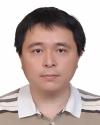研究成果 - 許良彥 博士
尖端材料與表面科學組

Theory of molecular emission power spectra. II. Angle, frequency, and distance dependence of electromagnetic environment factor of a molecular emitter in plasmonic environments [Special Issue: 2021 JCP Emerging Investigators Special Collection]
Journal of Chemical Physics 155, 074101 (2021); https://doi.org/10.1063/5.0057018
Our previous study [S. Wang et al., J. Chem. Phys. 153, 184102 (2020)] has shown that in a complex dielectric environment, molecular emission power spectra can be expressed as the product of the lineshape function and the electromagnetic environment factor (EEF). In this work, we focus on EEFs in a vacuum–NaCl–silver system and investigate molecular emission power spectra in the strong exciton–polariton coupling regime. A numerical method based on computational electrodynamics is presented to calculate the EEFs of single-molecule emitters in a dispersive and lossy dielectric environment with arbitrary shapes. The EEFs in the far-field region depend on the detector position, emission frequency, and molecular orientation. We quantitatively analyze the asymptotic behavior of the EFFs in the far-field region and qualitatively provide a physical picture. The concept of EEF should be transferable to other types of spectra in a complex dielectric environment. Finally, our study indicates that molecular emission power spectra cannot be simply interpreted by the lineshape function (quantum dynamics of a molecular emitter), and the effect of the EEFs (photon propagation in a dielectric environment) has to be carefully considered.
link: 相關連結
目前位置:本所人員 / 研究人員 / 許良彥 / 研究成果
中央研究院 原子與分子科學研究所版權所有 |
個人隱私權聲明 |
保有個資檔案公開項目彙整表 |
行動版
地址: 106319 台北市羅斯福路四段一號 或 106923 臺北臺大郵局 第23-166號信箱
電話:886-2-2362-0212 傳真:886-2-2362-0200 電子郵件:iamspublic@gate.sinica.edu.tw
最後更新於 2024-04-18 10:04:47
地址: 106319 台北市羅斯福路四段一號 或 106923 臺北臺大郵局 第23-166號信箱
電話:886-2-2362-0212 傳真:886-2-2362-0200 電子郵件:iamspublic@gate.sinica.edu.tw
最後更新於 2024-04-18 10:04:47
 中央研究院 原子與分子科學研究所
中央研究院 原子與分子科學研究所
